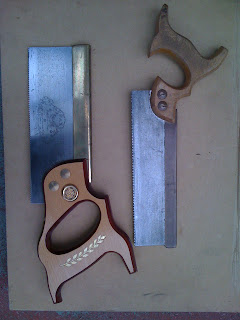The Cajon Drum post on my other blog has generated a fair bit of traffic, so here is more info and a few suggestions about how to make these wonderful instruments. It is a great project for kids to make and play... like it is for adults too.
The material I use is mostly 12mm (1/2") plywood, except for the drum face which is much thinner plywood. Because I am a committed wood recycler, most of this ply I use is wood rescued from the waste stream, obtained from packing crates and packaging, construction sites, and anywhere else I can source it.
 |
| My favourite sound hole style in the side. Drum face painted with actual mulberries. |
Cajon Drums come in many shapes and sizes, and range from simple versions to very complex ones. I tend to do two versions. These are basically the same dimensions except for the height. I do the adult versions 100mm (4mm) taller than the kids version.
The plan above shows the two sizes I commonly use, with the adult drum sides being 500mm long and the kids drum sides being 400mm long (tall). The top and bottom is the same size on both models of the drum. This makes component preparation and management much easier.
Construction.
The drums are assembled such that the sides and back sit between the top and bottom. This makes sense structurally as the drum is sat on in order to be played. The back of the drum is cut to fit within the sides, so it is captured between the sides and ends around it.
These butt joints are perfectly adequate as they are glued and nailed. Solid as a rock. I have kids aged 6 and upwards as well as adults making these drums in this way, and the simple construction is ideal.
The Sound Hole.
The sound hole is cut in one side usually before the drum face is fixed on. The sound hole can be cut in the side prior to assembly of the box, or it can be done when the box is all assembled bar the drum face. I usually get kids to do the latter, as it makes holding the box easy, as can be seen in the picture below.
 |
| After all is glued and nailed together except the face, the sound hole is then cut out. |
The sound holes I do with my workshop participants are based around the use of a brace and bit and saws.
The simplest method is what I call "Random Holes", where a bunch of randomly placed holes of various diameters are bored in one side using a brace and bit - looks a bit like Swiss Cheese.
The "Dog Bone" is the next easiest, created by boring two holes and using saws to cut out a slot between the holes. A bit like a vertical letterbox slot with enlarged ends. Sometimes people choose to do two of these features, parallel to each other.
My favourite is effectively two crossed Dog Bones, which makes a very nice cross shape. You can see there's one pictured (near the top of this post) on the Mulberry Drum.
A sound hole is essential, but the shape possibilities are infinite. It's fun to design and make your own, so long as it complies with a couple of basic rules. I usually suggest the cut-outs are never less than 50mm (2") from any of the 4 edges on the sound hole's side. I reckon you don't want the sound hole to be more than 20% of the total area of the side in which it is situated. Other than that, the sky's the limit. I find the brace and bit and saws work really well for kids.
 Almost there now... gluing and nailing on the drum face |
The drum face is made from thin ply, anywhere between 3mm and 6mm (1/8" - 1/4"). Fixing on the face is the last part of the main construction process. I usually use wallboard nails, 16-19mm long (5/8 - 3/4"), with a good spread of glue on the surfaces on which the face is to be fixed.
It may be possible to just use a good glue, and no nails - so long as there is a good spread of glue and the face is cramped on while the glue is drying. However, I use nails to do the cramping, because when I run workshops making these drums, we sit on them and play them together as soon as we have finished. That's the whole idea! The glue and nail method enables this. The glue I used helps - Titebond III. It is a very quick drying and strong woodworking glue.
 |
| The fun of playing the drums together as soon as we've finished making them. |
Personalising the drums.
Workshop participants take home their drums in a raw state. Here is a golden opportunity to decorate the drums! People do a wonderful variety of designs on their drums.
 |
| Decorating the drums is lots of fun when they are done. A sealer then goes over the top. |
The Mulberry Drum pictured at the start of this post I did after the workshop where I had made it as a demo. There was a big mulberry tree covered in fruit which I'd been helping myself to, and I used the actual fruit to draw on the drum. I then brushed a coat of shellac over the top to seal it. Sweet.
 |
| This drum was painted by my grand kids. Zoe (aged 11) in full flight. |
I hope this additional information has been useful for you if you're considering making your own Cajon drum. ... Happy sawing, hammering, drilling and drumming!!




































